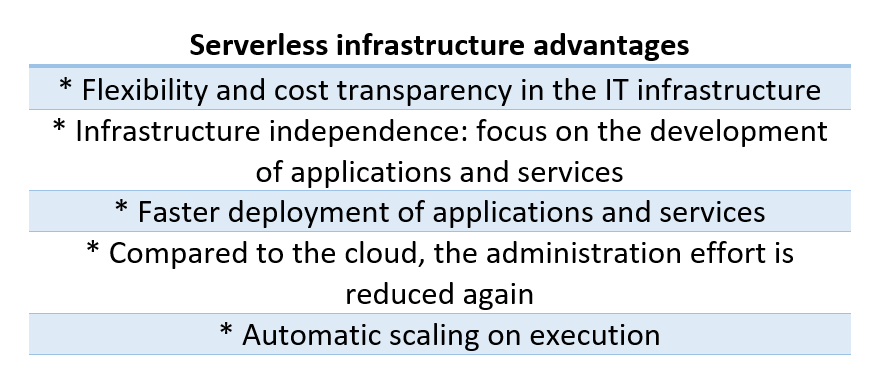Serverless: Knowing its limitations means using it properly

“Serverless” is one of the new hype words in the IT industry. According to MarketsandMarkets Analysis, the global serverless architecture market size is projected to grow from USD 7.6 billion in 2020 to USD 21.1 billion by 2025, at a Compound Annual Growth Rate (CAGR) of 22.7% during the forecast period. The major growth driving factors of the serverless architecture market include the rising need to shift from CAPEX to OPEX by removing and reducing the infrastructure cost. Gartner analysts also predict that half of all companies worldwide will have implemented a serverless model by 2025, compared to 20 percent today.
However, the term “serverless” is sometimes misunderstood. It’s not about getting rid of system hardware entirely. Rather, it’s about a new idea of managing applications and apps while still carrying out basic operations as usual. In plain language, this means: With serverless, the technical, application-relevant level of system architecture is managed independently of hardware-specific issues. The app managers only take care of the top functional level or the service. The cloud platform takes care of the provisioning logic, right through to the virtualization of resources and server control, giving the app manager room for other activities.
Serverless computing is an architecture where a cloud provider fully manages code execution, instead of the traditional method of developing & deploying applications on servers. Gartner believes that serverless computing requires IT leaders to take an application-centric approach. Instead of physical infrastructure, interfaces for application programming (APIs) and service level agreements (SLAs) are managed. Thus, developers and businesses can run their services without carrying the burden of managing the underlying infrastructure. Pricing is based on an application’s actual resource consumption, not prepaid capacity units. Also, server management decisions and capacity planning decisions are transparent to the user.
Even though the entry into the world of serverless is quite easy, the complexity increases very quickly when developers want to use more sophisticated resources, such as API gateways that sit between the client and several backend services and the calls management. The more the respective company builds on serverless architectures, the greater the danger of vendor lock-in. Decision-makers should keep this in mind if they want to define a serverless strategy that allows them to avoid long-term vendor and security risks. If there is a corresponding awareness in the company, it can use the advantages of serverless without having to fear potential pitfalls.
You must also acknowledge that serverless architecture is not the right choice for all cases. If the designated “serverless” application requires significant scaling and generates extremely high traffic for prolonged periods of time, it can become expensive. In this case, a cheaper alternative is a computer cloud such as Amazon EC2, which provides computing capacity in the cloud. Serverless scenarios are also unsuitable for applications that require noticeably short response times, such as real-time applications.
The mindset of the developers must also match the specific requirements of serverless. For example, it is imperative that they have an in-depth understanding of how serverless and event-driven architectures are built. Developers must also know the specifications and limitations of the platform used and keep an eye on application and data security. The risks and consequences of implementing serverless are severe unless the benefits have been demonstrated for a specific use case and the organization has carefully considered the ultimate costs and outcomes. Decision-makers should therefore only decide on a potential switch to serverless based on a detailed cost-benefit analysis.
The benefits of serverless computing are increased agility, unlimited scalability, easier maintenance, lower costs, and back-end services provided by the provider. It also ensures that companies and their developers no longer must worry about the servers and their configuration. In addition, serverless computing supports multi-cloud environments and makes the pay-as-you-go model a reality. Furthermore, the serverless approach promotes the sustainability of data-supported strategies in financial terms. And that’s exactly why serverless computing is reshuffling the cards in data integration. Now the possibilities in the field of data-on-demand are almost unlimited. Because companies can decide how, where, and when they process data in a way that makes economic sense for them.

